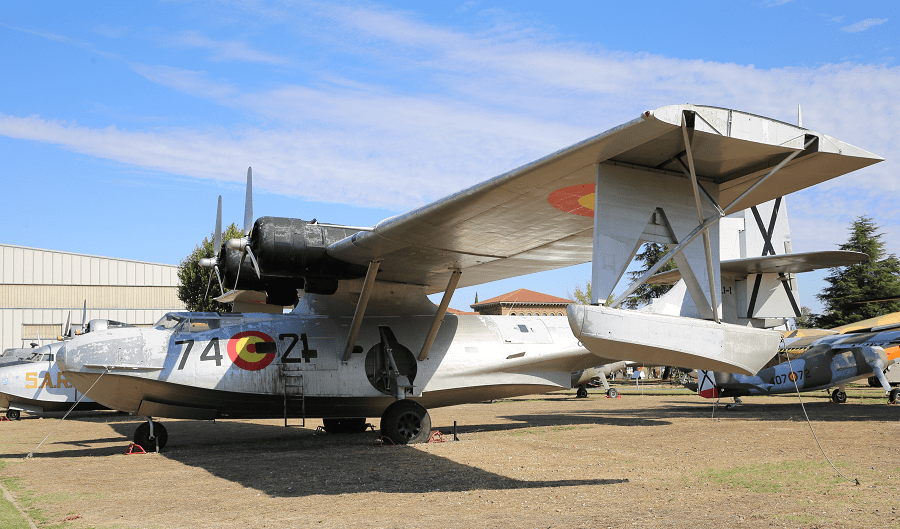The Consolidated PBY Catalina is a flying boat and amphibious aircraft that was produced in the 1930s and 1940s. In Canadian service it was known as the Canso. It was one of the most widely used seaplanes of World War II.
Catalinas served with every branch of the United States Armed Forces and in the air forces and navies of many other nations. The last military PBYs served until the 1980s. As of 2021, 86 years after its first flight, the aircraft continues to fly as a waterbomber (or airtanker) in aerial firefighting operations in some parts of the world. None remain in military service.
The PBY was originally designed to be a patrol bomber, an aircraft with a long operational range intended to locate and attack enemy transport ships at sea in order to disrupt enemy supply lines. With a mind to a potential conflict in the Pacific Ocean, where troops would require resupply over great distances, the U.S. Navy in the 1930s invested millions of dollars in developing long-range flying boats for this purpose. Flying boats had the advantage of not requiring runways, in effect having the entire ocean available.
- Manufacturer: Consolidated Aircraft
- Built by: Boeing Canada (PB2B), Canadian Vickers (PBV), Naval Aircraft Factory (PBN), Soviet Gidrosamolet Transportnii factory at Taganrog (GST)
- First flight: 21 March 1935
- Introduction: October 1936, United States Navy
- Retired: January 1957 (United States Navy Reserve), 1982 (Brazilian Air Force)
- Primary users: United States Navy, United States Army Air Forces, Royal Air Force, Royal Canadian Air Force\
- Produced: 1936–1945
- Number built: 3,308
General characteristics
- Crew: 10 (pilot, co-pilot, bow turret gunner, flight engineer, radio operator, navigator, radar operator, two waist gunners and ventral gunner)
- Length: 63 ft 10.875 in (19.47863 m)
- Wingspan: 104 ft (32 m)
- Height: 21 ft 1 in (6.43 m)
- Wing area: 1,400 sq ft (130 m2)
- Aspect ratio: 7.73
- Empty weight: 20,910 lb (9,485 kg)
- Max takeoff weight: 35,420 lb (16,066 kg)
- Zero-lift drag coefficient: 0.0309
- Drag area: 43.26 ft2 (4.02 m2)
- Powerplant: 2 × Pratt & Whitney R-1830-92 Twin Wasp 14-cylinder air-cooled radial piston engines, 1,200 hp (890 kW) each
- Propellers: 3-bladed constant-speed propellers
Performance
- Maximum speed: 196 mph (315 km/h, 170 kn)
- Cruise speed: 125 mph (201 km/h, 109 kn)
- Range: 2,520 mi (4,060 km, 2,190 nmi)
- Service ceiling: 15,800 ft (4,800 m)
- Rate of climb: 1,000 ft/min (5.1 m/s)
- Lift-to-drag: 11.9
- Wing loading: 25.3 lb/sq ft (124 kg/m2)
- Power/mass: 0.067 hp/lb (0.110 kW/kg)
Armament
- Guns: 3 x .30 cal (7.62 mm) machine guns (two in nose turret, one in ventral hatch at tail)
2 x .50 cal (12.7 mm) machine guns (one in each waist blister) - Bombs: 4,000 lb (1,814 kg) of bombs or depth charges; torpedo racks were also available
The Consolidated Aircraft Corporation was founded in 1923 by Reuben H. Fleet in Buffalo, New York, the result of the Gallaudet Aircraft Company’s liquidation and Fleet’s purchase of designs from the Dayton-Wright Company as the subsidiary was being closed by its parent corporation, General Motors.
Consolidated became famous, during the 1920s and 1930s, for its line of flying boats. The most successful of the Consolidated patrol boats was the PBY Catalina, which was produced throughout World War II and used extensively by the Allies. Equally famous was the B-24 Liberator, a heavy bomber which, like the Catalina, saw action in both the Pacific and European theaters.
In 1943, Consolidated merged with Vultee Aircraft to form Consolidated-Vultee Aircraft, later known as Convair. The Los Angeles-based Consolidated Steel Corporation is not related.












